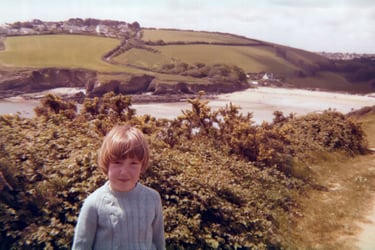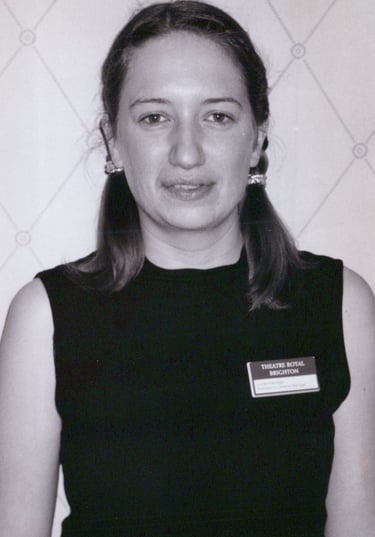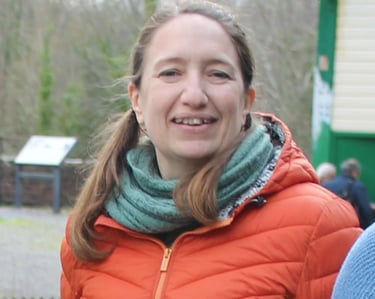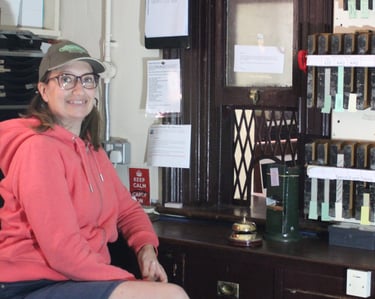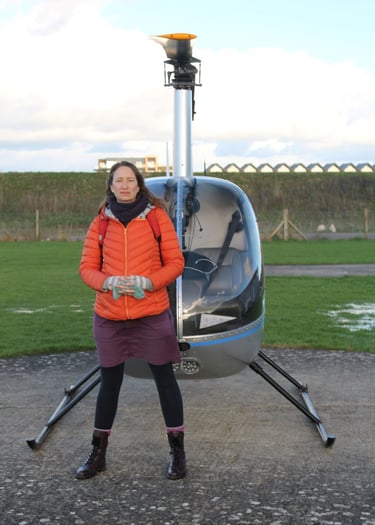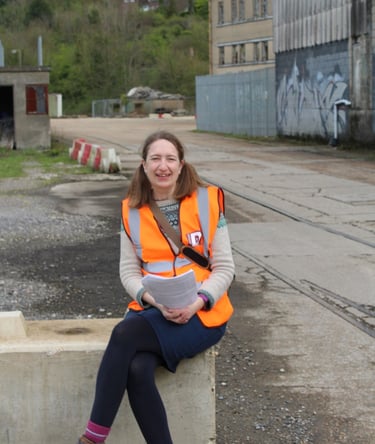Meet Lou Kirk-Partridge, Producer
Series Catchphrase: "No, Stephen, no…”
(you cannot put a cow on a train)
Lou Kirk-Partridge, Producer
Producer. Creative project leader, artist, rehab specialist (it helps). The ordered mind and voice of reason behind the wild journey of Tracing the Rails. Oh, and a railwayman’s daughter, coal dust and diesel in the blood. I live in Upper Beeding on the edge of Steyning in West Sussex. I grew up in Buckinghamshire with parents from Cornwall and the Black Country, a teacher and a locomotive driver, which made for a great combination of accents in the household. After school I moved to London to study Illustration at university and then down to the South Coast to be near the sea, which I love.
I’ve been a freelance illustrator, artist and creative workshop leader since then, combining this with three different careers as my ‘day job’. First in fine art and graphics supplies – working for companies in London and Brighton and leaving me with a huge knowledge (& collection) of art materials. Then into the Theatre, where I learnt about running businesses and leading teams in my roles in theatre management and front of house leadership. I met a lot of interesting people in the theatres, and many creative opportunities came my way. I created costumes, props, and ran creative workshops as part of community programmes. This career took me to Brighton, London, Chichester and Worthing.
Career three, which continues to this day is in rehabilitation and wellbeing through creativity. My specialist areas are working with adults with a learning disability, people with a visual impairment and the Blind, people with dual sensory loss, military veterans, elders and those living a paced lifestyle. I’ve led services for a local and a national charity, creating accessible programmes of meaningful creative activity for their client groups. I also work as a freelance creative wellbeing practitioner, consultant, tutor and project leader.
Apologies for ignoring early career advice not to follow a creative path. I’m sure had in gone into’t factory or gotten a nice little job as a secretary (“because you are a bright girl”) as suggested, I would be a lot richer but reflections on my deathbed would no doubt be less rewarding. I’ve always loved history; the exploring in real life sort of history rather than the academic book kind. I grew up a railway child, life revolving around my dad’s job on the railways. From the day to day ‘earlies’, ‘lates’, ‘nights’ having to play quietly because daddy was sleeping, to holidays travelling the railway network and staying in railwaymen's B&Bs which were advertised in the back of Railnews. I love locos from the magical and awesome steam engines, to the screaming intercity diesels. There is something very thrilling about the power of the engine as they get themselves ready to pull a train out of a station. And then the comforting journeys in the old ‘thumper’ DMUs, Bletchley to Bedford, St Erth to St Ives, Birmingham New Street to The Lye, the purring and growling of the engine in a comfy yet slightly itchy seat. The excitement of seeing different worlds pass by, brickworks, airship hangars, wind blown beaches, tin mines, terraced houses, factories and workshops. The trains, the journeys, my life and my heritage are tied together and feel like home.
I met Chris Kirk in a car park and we discovered we had a lot in common, so we got married. Before Tracing the Rails we ran a Radio Play Society together for blind military veterans. Our plays made it onto the radio. If you search hard you might still find a few out there. We had a lot of fun with that project.
How did I get to be Producer of Tracing the Rails? I’d like to say it’s because the team had heard of my legendary project management skills and winsome personality and headhunted me for the job (for a huge salary…). But actually - Tracing the Rails was my idea to remedy a husband who spent a lot of time lamenting the loss of the film making days of his youth. (And his youth, but that’s another story). I decided we would make a little film project for fun, in our local area, and because we love walking, cycling, history, landscape and wildlife, our oft visited local Steyning Line, now the Downslink path, seemed a great place to start. We were excited to put it up on You Tube and at the prospect we might, if we were lucky, reach a few hundred views from elderly rail history enthusiasts.
What do I bring to the team? I feel a bit like the mum of the team. The Others get all excited and wild about doing stuff and I rein them in, make a plan, stop them from buying too much new kit and then chase them around with bottles of water, sun cream, hats, coats and make them stop for lunch etc as they get carried away filming. When I’m occasionally unable to be there on a shoot they just carry on all day and return home having eaten only a tube of smarties, dehydrated and covered in sun burn.
A funny moment for me but not really for Stephen was when, after about 15 takes of trying to film next to the Old Toll Bridge in Shoreham on a sunny day when people kept walking past on a very noisy gravel path he finally lost his cool and had a little rant about people scrunching on the gravel. Obviously we have destroyed the footage of that…(keep up the payments Stephen).
My role involves comms – email, phone calls, social media, in person; research, planning, scheduling, stills photography, editing The Engine Shed, assisting on shoots.
So, I’ve been asked a few times “how do you make Tracing the Rails - do you just go out and then make it up as you go?” “Do you have a plan in advance? Do you have a script?”. The answer is yes, of course we have a plan! The secret of success with TTR is the research, planning, and scripting we do before the shoot. It gives a structure and a framework to work from. We add and change things as we go, and the script is not a line for line set of words, but facts and details to film are all carefully planned.
What I like most about my role is the challenge of having to learn new things and the variety of stuff I have to do to make things work. Oh, and being part of a really great team. And the lunches.
My profession of Illustrator is all about telling a story so working on a TV show just takes this idea a bit further. I studied photography in my teens and a significant part of many of my jobs has been taking photos for publicity so documenting the making of TTR is just more of the same and something I really enjoy.
I play the flute and have been lucky enough to play alongside our railway folk band on some of the tracks for the show. I illustrated the backdrops and characters for our Railway200 celebration animation. And got 1 line of dialogue in it too!
Making TV shows runs in my genes with family contributions in the puppet-making and puppeteering fields to the original Star Wars films, Jim Henson’s productions and Rainbow. I’m proud to be related to Zippy (thank you Aunty Violet!).
I hope people watching Tracing the Rails will feel inspired to get outside and explore the history and landscape of their local area, enjoying the adventure as much as we do.
In an ever changing world where people are often scattered far and wide from their ancestral roots, I feel learning about the heritage of the area you live in, the people and times that have come before you on the land you now occupy, is an important and grounding connection that helps you feel secure in life. Part of this is hearing stories from people who remember when things were not as they are today. I’m so happy that through Tracing the Rails we’ve managed to make a record of some of these local stories.
My hope for Tracing the Rails is that we will find the support through funding to make more similar work as a full time occupation for us all. We are a multiskilled, multi-talented team, who work really well together. It would be great to have the opportunity to follow other lost railway lines and indeed, lines of history and heritage and Carry On Tracing the Rails.
A couple of my friends have always joked that they are going to put ‘Partridge. She was a game bird’ on my gravestone, which I think is quite a nice summary to leave to the world. My personal recurring quote when faced with something new and challenging is the line “well, how difficult can it be?…” which I very much like, and stand by*.
*except in the case of being asked to perform any sort of serious medical procedure, bomb disposal or work with spiders.
